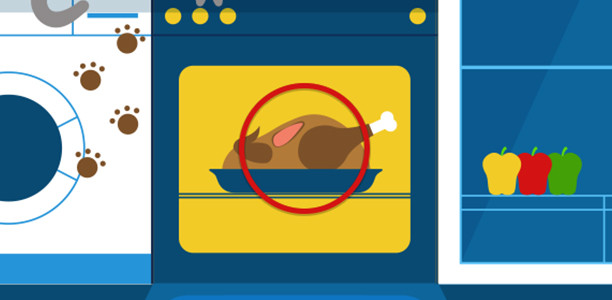Identify and explain food safety hazards in a kitchen
Hazards in the Kitchen
Identify and explain food safety hazards in a kitchen

- HWB 2-16a
- HWB 2-33a
- identify hazards within a kitchen setting
- link kitchen hazards to possible consequences
- suggest ways to prevent or remove these hazards
Resources
- kitchen interactive scene
- worksheet for pupils with additional support needs
Setting up
Display the kitchen interactive on the whiteboard.
Activities
- pupils identify food safety hazards on the kitchen interactive
- allow some time to discuss as a whole class the consequences of these hazards
- split pupils up into small groups
- each group is allocated one of the food safety hazards and must come up with a short drama that shows:
- what happened to cause the hazard
- what the hazard is
- what the consequences of the hazard might be
- what could have been differently to ensure safety.
- pupils come together after allocated time to watch each group’s drama.
- if possible, each group could put their dramas together as a sequence and present it to another class or at an assembly.
Cross-curricular links
Expressive Arts – Drama
The Royal Environmental Health Institute of Scotland (REHIS) offers secondary schools in Scotland the opportunity to become registered with the Institute to deliver some of the REHIS qualifications – see www.rehis.com/community-training for information on the REHIS Schools Food Hygiene Initiative contact REHIS.
Assessment opportunities
DO – Does the group’s performance demonstrate an understanding of the consequences of kitchen hazards and how to prevent them?
Consider CfE Benchmarks, for example:
- Identifies ways to reduce the risks of food poisoning, for example reheating food until piping hot, safe food storage, different coloured chopping boards.
Differentiation
Adaptations for pupils with additional support needs
- some children with ASN may find an open-ended drama task very difficult
- another way of achieving the learning intentions for this lesson while encouraging pupils to be creative in their thinking could be with the use of comic strips
- using the accompanying sheet (photocopied onto A3), pupils draw comic strip-style pictures before and after each hazard showing what might have caused it and what the consequence of it might be
- pupils could then make an alternative comic strip starting with their picture of what happened first and adding on to it what should have been done
Challenge
- groups could create a script for their performance
- explore the use of other drama conventions such as the use of mime, voice over or freeze frame
